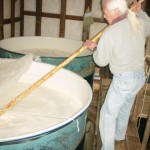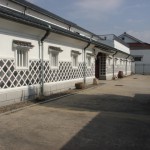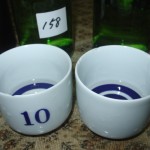It’s complicated…
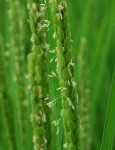 Last time, we looked at the idiosyncratic rice distribution system in Japan, and how that affects the 1.4% of all rice that sake rice represents, with the main points being that brewers themselves almost never own the fields, and that the majority of sake rice, by far, is distributed by powerful agricultural cooperatives, a system that has its attendant strengths and weaknesses.
Last time, we looked at the idiosyncratic rice distribution system in Japan, and how that affects the 1.4% of all rice that sake rice represents, with the main points being that brewers themselves almost never own the fields, and that the majority of sake rice, by far, is distributed by powerful agricultural cooperatives, a system that has its attendant strengths and weaknesses.
As rice distribution in Japan is deeply rooted in all that Japan is, a comprehensive study would extend beyond the interest and attention span of even the most ardent readers and sake fans. So let us keep close to how it relates to sake in what follows here.
In truth, there is a lack of clarity related to all things rice-distribution in Japan, much of which affects the sake world. For example, while the rice for top grades of sake is fairly easy to order and trace, remember that most sake is not premium, and the rice that goes into that lion’s share of sake on the market – while cheaper than top-grade sake rice – is a driving element in the sake industry. In other word, most of the sake on the market is made of this somewhat lesser, significantly less expensive rice. So when the supply of that is threatened, the effect on the market is huge.
And that is what we have happening right now. There is a system of supplying rice within the current distribution system in which brewers can specify a minimum of information about the rice as a request, but what they get may be different. But it won’t matter, at the level at which they are using it. The system refers to such rice as “kakomai,” but let us call it the “cheap rice system” here, abbreviated CRS.
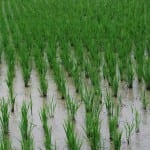 So, what is purchased through the CRS is somehow subsidized by local prefectural governments. And the rice itself can be a blend of stuff that was left over from higher than expected yields or lower than expected orders, or perhaps some of the less-carefully grown stuff. And all mixed together as well. But it is very inexpensive, comparatively speaking.
So, what is purchased through the CRS is somehow subsidized by local prefectural governments. And the rice itself can be a blend of stuff that was left over from higher than expected yields or lower than expected orders, or perhaps some of the less-carefully grown stuff. And all mixed together as well. But it is very inexpensive, comparatively speaking.
But in truth, as mentioned above, it won’t really matters as it will be used for cheaper sake, and it will do fine. Having said this, though, remember that cheaper sake is 65 percent of the market.
Who can grow what, and how much of it, is strictly controlled by the government so as to avoid having excess stock and thereby adversely affecting market stability. However, there are some gaps and loopholes and options open to the farmers. There is no obligation to grow rice that would be used in the CRS system. And over the past couple of years we have seen more farmers move away from rice that could be used for sake brewing and growing vastly inferior rice that can be used for animal feed.
Why? Because government subsidies for fertilizers and insecticides and the like are higher for fields allotted to the animal-feed rice. On top of that, fields on which such animal-feed rice are grown do count toward the allotment of land upon which a farmer is permitted to grow rice. So, they get more subsidies, and can grow as much as they want. No wonder they choose that over rice that could go through the CRS and be used for sake.
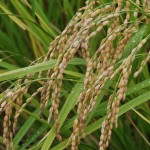 Why would animal-feed rice be favored? Because that limits the need to import it, helping to offset trade imbalances, as well as assisting local agricultural. Good reasons to be sure! But the effects on sake could be big. How big? Hm. Once source has said that only 30 percent of the orders can be filled with inexpensive CRS rice, and that the cost of said rice would increase by as much as 25 percent. That will undoubtedly affect the brewing industry in both profitability (to the degree that it actually exists!) and consumer prices too. Apparently the situation is fairly grave.
Why would animal-feed rice be favored? Because that limits the need to import it, helping to offset trade imbalances, as well as assisting local agricultural. Good reasons to be sure! But the effects on sake could be big. How big? Hm. Once source has said that only 30 percent of the orders can be filled with inexpensive CRS rice, and that the cost of said rice would increase by as much as 25 percent. That will undoubtedly affect the brewing industry in both profitability (to the degree that it actually exists!) and consumer prices too. Apparently the situation is fairly grave.
Note too that not absolutely everyone is affected. A few large and stable breweries have the economies of scale in buying power to negotiate cheap enough prices for high enough volumes where they do not need such rice. So they are immune. And some premium brewers do not mess with that rice either, using only contract-grown rice or top-grade sake rice. But most of the 1350 breweries remaining will be affected.
Also, the impending developments related to the multinational economic agreement known as the Trans-Pacific Partnership, or TPP, may drastically affect things as well by opening up Japan to very cheap rice imports – if, that is, Japan chooses to fully participate. When I asked one brewer about it, he insisted it was a very good thing, and that Japan’s rice system desparately needed to change, and that despite the short term pain in would be good for Japan in the long run. However, became so passionate (read: irate) that I could not longer understand his rant, fading off into a local accent as he did. So the details were lost on me but I got the gist.
Next, remember, brewers have to buy all that rice up front. Which means, every autumn, many have to significantly strain their finances just to start the season, the return on which they will not begin to see for a year at least. Securing and backing the requisite support in a fragile economy for a contracting industry is another big issue.
There are more vagaries that the rice growing cartel, er, communities employ, and often the sake brewers themselves do not fully understand. I remember one brewer from Shiga, near Kyoto, telling me that they were finally able to grow Yamada Nishiki in Shiga. “You mean, you could not grow it here before? But I know I have had Shiga sake made with Shiga-grown Yamada Nishiki,” I asked inquisitively.
“Well,” he stammered, “you can, but you cannot put it on the label – until now.”
“Oh?,” I continued. “Who controls that?” I asked out of sincere interest. Rice growing is controlled by one industry, sake labeling by another. I sensed a disconnect. And so did he.
He thought a second, and said, “Wow. I don’t know. That’s just what the farmers told me. Let me check on that and get back to you!”
Yet another brewer from Yamagata told me that he had been told that one could not put the name of the rice on the label unless the seeds came from an official source, i.e. the cooperative. Huh? Sez who? And enforced by who? Is this the law, I asked?
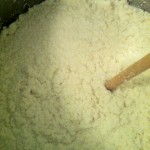 “It’s, uh, vague,” said my Yamagata brewer friend. “And the frustrating thing is that the folks distributing the rice keep it that way. Those that know keep it vague! I could explore it further, and challenge it, but I have other higher priorities. So we just deal with it,” he acquiesced.
“It’s, uh, vague,” said my Yamagata brewer friend. “And the frustrating thing is that the folks distributing the rice keep it that way. Those that know keep it vague! I could explore it further, and challenge it, but I have other higher priorities. So we just deal with it,” he acquiesced.
Sake is unique in many ways. For better or for worse, the extremely high cost of the raw material is one of those ways. And the byzantine distribution system – while it serves some purpose indeed – is yet another. Let your understanding of this add to your appreciation of all that goes into the glass of sake before you!
~~~~~~~~~~~~~~~~~~~~~~~~~~~~~~~~~~~~~~~~~~~~~~~~~~~~~~~~~~~~~~
Dallas, Texas, August 8~10, 2013
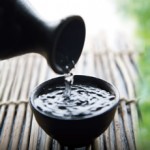 The next Sake Professional Course will take place August 8-10, in conjunction with TEXSOM 2013 at the Four Seasons Resort and Club Dallas at Las Colinas in Irving, Texas
The next Sake Professional Course will take place August 8-10, in conjunction with TEXSOM 2013 at the Four Seasons Resort and Club Dallas at Las Colinas in Irving, Texas
More about the seminar, its content and day-to-day schedule, can be found here:
http://www.sake-world.com/html/spc_texsom_2013.html
The Sake Professional Course, with Sake Education Council-recognized Certified Sake Professional certification testing, is by far the most intensive, immersing, comprehensive sake educational program in existence. The three-day seminar leaves “no sake stone unturned.”
The tuition for the course is $825. Feel free to contact me directly at sakeguy@gol.com with any questions about the course, or to make a reservation.
 Several municipalities and one prefecture have recently put into effect actual legal ordinances dictating that if you say “kamapai!” it must be with sake (or in one case, shochu, Japan’s indigenous distilled beverage).
Several municipalities and one prefecture have recently put into effect actual legal ordinances dictating that if you say “kamapai!” it must be with sake (or in one case, shochu, Japan’s indigenous distilled beverage).




